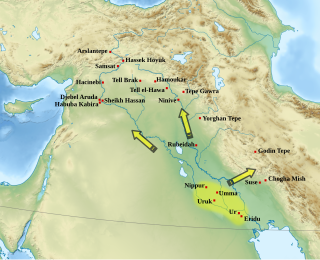
A Linux distribution is an operating system made from a software collection that includes the Linux kernel and often a package management system. They are often obtained from the website of each distribution, which are available for a wide variety of systems ranging from embedded devices and personal computers to servers and powerful supercomputers.
Uruk, today known as Warka, was a city in the ancient Near East situated east of the present bed of the Euphrates River on the dried-up ancient channel of the Euphrates. The site lies 93 kilometers northwest of ancient Ur, 108 kilometers southeast of ancient Nippur, and 24 kilometers southeast of ancient Larsa. It is 30 km (19 mi) east of modern Samawah, Al-Muthannā, Iraq.
urpmi is a package management tool for installing, removing, updating and querying software packages of local or remote (networked) media. It wraps around the RPM Package Manager in the role of a smart package manager. It uses repositories and will resolve dependencies so that the user will not suffer from dependency hell that can happen when using RPM directly. It works with official sources from Mandriva or unofficial sources such as those from the Penguin Liberation Front. It has a graphical front-end: Rpmdrake.

The GNU/Linux naming controversy is a controversy regarding whether computer operating systems that use GNU software and the Linux kernel should be referred to as "GNU/Linux" or "Linux" systems.
Mint or The Mint may refer to:

The Uruk period existed from the protohistoric Chalcolithic to Early Bronze Age period in the history of Mesopotamia, after the Ubaid period and before the Jemdet Nasr period. Named after the Sumerian city of Uruk, this period saw the emergence of urban life in Mesopotamia and the Sumerian civilization. The late Uruk period saw the gradual emergence of the cuneiform script and corresponds to the Early Bronze Age; it has also been described as the "Protoliterate period".
Distribution may refer to:
Linux is a family of computer operating systems based on the Linux kernel.

Linux is both an open-source Unix-like kernel and a generic name for a family of open-source Unix-like operating systems based on the Linux kernel, an operating system kernel first released on September 17, 1991, by Linus Torvalds. Linux is typically packaged as a Linux distribution (distro), which includes the kernel and supporting system software and libraries, many of which are provided by the GNU Project. Many Linux distributions use the word "Linux" in their name, but the Free Software Foundation uses and recommends the name "GNU/Linux" to emphasize the use and importance of GNU software in many distributions, causing some controversy.
Flavour or flavor is either the sensory perception of taste or smell, or a flavoring in food that produces such perception.
Naram-Suen (Naram-Sin) may refer to any of four kings in the history of Mesopotamia:

According to the Free Software Foundation Latin America, Linux-libre is a modified version of the Linux kernel that contains no binary blobs, obfuscated code, or code released under proprietary licenses. In the Linux kernel, they are mostly used for proprietary firmware images. While generally redistributable, binary blobs do not give the user the freedom to audit, modify, or, consequently, redistribute their modified versions. The GNU Project keeps Linux-libre in synchronization with the mainline Linux kernel.

Uruk GNU/Linux-libre is a PureOS-based Linux distribution. The name Uruk is an Iraqi city that states its Iraqi origin. Uruk GNU/Linux 1.0 was released on 13 April 2016 and it ships with the most common software for popular tasks.
gLinux is a Debian Testing-based Linux distribution used at Google as a workstation operating system. The Google gLinux team builds the system from source code, introducing their own changes. gLinux replaced the previously used Ubuntu-based distribution, Goobuntu. gLinux is usually installed by loading into a bootstrap environment when it is first booted up. When it is started, the root files are unpacked and the Debian installer starts to perform the installation. According to a former user of the OS, it uses the Cinnamon desktop environment. Over the years, Google has focused on speed, scale and data, which is the thought process that allowed them to move to gLinux. Google used Ubuntu before switching to gLinux; however, the two years of security updates it provided meant that planning for the next upgrade would take close to a year.
This page is based on this
Wikipedia article Text is available under the
CC BY-SA 4.0 license; additional terms may apply.
Images, videos and audio are available under their respective licenses.




